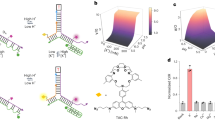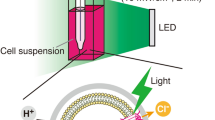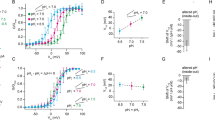Abstract
Measurement of extracellular acidification rates by microphysiometry provides a means to analyze the function of ion channels expressed in yeast cells. These measurements depend on the proton pumping action of the H+-ATPase, a central component of the yeast plasma membrane. We used microphysiometry to analyze the activity of two ion channels expressed in yeast. In one example, an inwardly rectifying K+ channel, gpIRK1, provides a potassium uptake function when expressed in a potassium transporter-defective yeast strain. Rates of acidification in gpIRK1-expressing cells directly reflect channel function. Addition of cesium, an inhibitor of gpIRK1 activity, results in an immediate reduction in acidification rates. In a second example, expression of a nonselective cation channel, the influenza virus M2 protein, is believed to interfere with the maintenance of the electrochemical proton gradient by the H+-ATPase. In cells expressing the M2 channel, addition of inhibitors increases the rate of proton extrusion. Moreover, functional differences between two M2 inhibitors, amantadine and BL-1743, are distinguished by the microphysiometer. This application demonstrates the utility of the microphysiometer for functional studies of ion channels; it is adaptable to a screening process for compounds that modulate ion channel activity.
This is a preview of subscription content, access via your institution
Access options
Subscribe to this journal
Receive 12 print issues and online access
$209.00 per year
only $17.42 per issue
Buy this article
- Purchase on Springer Link
- Instant access to full article PDF
Prices may be subject to local taxes which are calculated during checkout
Similar content being viewed by others
References
Iverson, L.E., Tanouye, M.A., Lester, H.A., Davidson, N., and Rudy, B. 1988. Expression of A-type potassium channels from Shaker cDNAs. Proc. Natl. Acad. Sci. USA 85: 5723–5727.
Papazian, D.M., Schwarz, T.L., Tempel, B.L., Jan, Y.N., and Jan, L.Y. 1987. Cloning of genomic and complementary cDNA from Shaker, a putative potassium channel gene from Drosophila. Science 237: 749–753.
Timpe, L.C., Schwarz, T.L., Tempel, B.L., Papazian, D.M., Jan, Y.N., and Jan, L.Y. 1988. Expression of functional potassium channels from Shaker cDNA in Xenopus oocytes. Nature 331: 143–145.
Hafeman, D.G., Parce, J.W., and McConnell, H.M. 1988 Light-addressable potentiometric sensor for biochemical systems. Science 240: 1182–1185.
McConnell, H.M., Owicki, J.C., Parce, J.W., Miller, D.L., Baxter, G.T., Wada, H.G., and Pitchford, S. 1992. The cytosensor microphysiometer: biological applications of silicon technology. Science 257: 1906–1912.
Owicki, J.C., Bousse, L.J., Hafeman, D.G., Kirk, G.L., Olson, J.D., Wada, H.G., and Parce, J.W. 1994. The Light-Addressable Potentiometric Sensor: principles and biological applications. Annu. Rev. Biophys. Biomol. Struct. 23: 87–113.
Miller, D.L., Olson, J.C., Parce, J.W., and Owicki, J.C. 1993. Cholinergic stimulation of the Na+/K+ adenosine triphosphatase as revealed by microphysiometry. Biophys. J. 54: 813–823.
Miller, D.L., and Owicki, J.C. 1994. Long term exposure of TE671 cells to PMA induces a change in metabolic and calcium responses to nACHR activation. Canadian J. of Physiology and Pharmacology. 72 (suppl. 1) 378.
Hahnenberger, K.M., Jia, Z.-P., and Young, P.G. 1996. Functional expression of the Schizosaccharomyces pombe Na+/H+ antiporter gene, sod2, in Saccharomyces cerevisiae . Proc. Natl. Acad. Sci. USA 93: 5031–5036.
Haworth, R.S., Lemire, B.D., Crandall, D., Cragoe, E.J. Jr., and Fliegel, L. 1991. Characterization of proton fluxes across the cytoplasmic membrane of the yeast Saccharomyces cerevisiae . Biochim. Biophys. Acta 1098: 79–89.
Serrano, R. 1991 Transport across yeast vacuolar and plasma membranes, pp. 523–585 in The molecular biology of the yeast Saccharomyces. Broach, J.R. et al. (eds.). Cold Spring Harbor Laboratory, Cold Spring Harbor, New York.
Gaber, R.F. 1992 Molecular genetics of yeast ion transport. Intl. Rev. Cytol. 137A: 299–353.
Haro, R., Garciadeblas, B., and Rodriguez-Navarro, A. 1991. A novel P-type ATPase from yeast involved in sodium transport. FEBS Lett. 291: 189–191.
Garciadeblas, B., Rubio, F., Quintero, F.J., Banuelos, M.A., Haro, R., and Rodriguez-Navarro, A. 1993. Differential expression of two genes encoding isoforms of the ATPase involved in sodium efflux in Saccharomyces cerevisiae . Mol. Gen. Genet. 236: 363–368.
Bussey, H., Boone, C., Zhu, H., Vernet, T., Whiteway, M., and Thomas, D.Y. 1990. Genetic and molecular approaches to synthesis and action of the yeast killer toxin. Experientia 46: 193–200.
Kagan, B. 1983. Mode of action of yeast killer toxins: channel formation in lipid bilayer membranes. Nature 302: 709–711.
Martinac, B., Zhu, H., Kubalski, A., Zhou, X., Culbertson, M., Bussey, H., and Kung, C. 1990 Yeast K1 killer toxin forms ion channels in sensitive yeast spheroplasts and in artificial liposomes. Proc. Natl. Acad. Sci. USA 87: 6228–6232.
Kubo, Y., Baldwin, T.J., Jan, Y.N., and Jan, L.Y. 1993. Primary structure and functional expression of a mouse inward rectifier potassium channel. Nature 362: 127–133.
Pinto, L.H., Holsinger, L.J., and Lamb, R.A. 1992. Influenza virus M2 protein has ion channel activity. Cell 69: 517–528.
Tu, Q., Pinto, L., Lou, G., Shaungessy, M.A., Mullaney, D., Kurtz, S., Krystal, M., and Lamb, R.A. 1996. Characterization of inhibition of M2 ion channel activity by BL-1743, an inhibitor of influenza A virus. J. Virology. In press.
Tang, W., Ruknudin, A., Yang, W.-P., Shaw, S.-Y., Knickerbocker, A., and Kurtz, S. 1995. Functional expression of a vertebrate inwardly rectifying K+ channel in yeast. Mol. Biol. Cell 6: 1231–1240.
Kurtz, S., Luo, G., Hahnenberger, K.M., Brooks, C., Gecha, O., Ingalls, K., Numata, K., and Krystal, M. 1995. Growth impairment resulting from expression of Influenza virus M2 protein in yeast: identification of an inhibitor of M2. Antimicrob. Agents Chemother. 39: 2204–2209.
Davies, W.L., Grunet, R.R., Haff, R.F, McGahen, J.W., Neumayer, E.M., Paulshock, M., Watts, J.C., Wood, T.R., Hermann, E.C., and Hoffmann, C.E. 1964. Antiviral Activity of 1-Adamantadine (Amantadine). Science 144: 862–863.
Kamb, A., Iverson, L.E., and Tanouye, M.A. 1987. Molecular characterization of shaker, a Drosophila gene that encodes a potassium channel. Cell 50: 405–413.
Butler, A., Tsunoda, S., McCobb, D.P., Wei, A., and Salkoff, L. 1993. mSlo, a complex mouse gene encoding Maxi calcium activated potassium channels. Science 261: 221–224.
Holsinger, L.J. and Lamb, R.A. 1991. Influenza virus M2 integral membrane protein is a homotetramer stabilized by formation of disulfide bonds. Virology 183: 32–43.
Jan, L.Y. and Jan, Y.N. 1994. Potassium channels and their evolving gates. Nature 371: 119–122.
Bertl, A., Andersen, J.A., Slayman, C.L, and Gaber, R.F. 1995. Use of Saccharomyces cerevisiae for patch-clamp analysis of heterologous membrane proteins: Characterization of KAT1, an inward-rectifier K+ channel from Arabidopsis thaliana, and comparison with endogenous yeast channels and carriers. Proc. Natl. Acad. Sci. USA 92: 2701–2705.
Sherman, F., Fink, G.R. and Hicks, J.B. 1983. Methods in yeast genetics. Cold Spring Harbor Laboratory, Cold Spring Harbor, New York
Author information
Authors and Affiliations
Rights and permissions
About this article
Cite this article
Hahnenberger, K., Krystal, M., Esposito, K. et al. Use of microphysiometry for analysis of heterologous ion channels expressed in yeast. Nat Biotechnol 14, 880–883 (1996). https://doi.org/10.1038/nbt0796-880
Received:
Accepted:
Issue Date:
DOI: https://doi.org/10.1038/nbt0796-880



